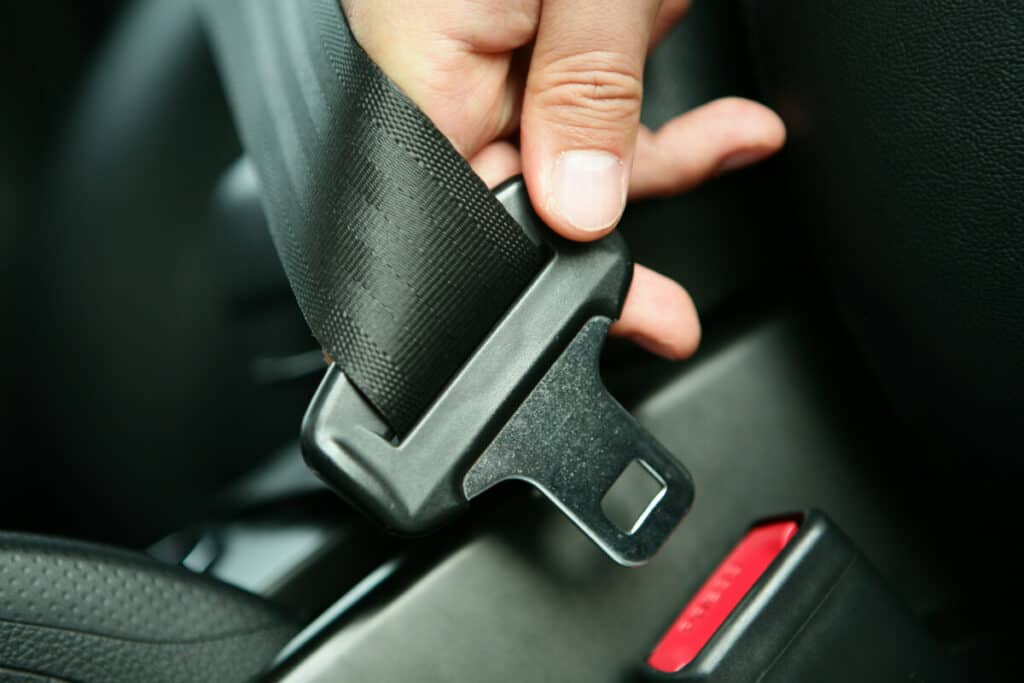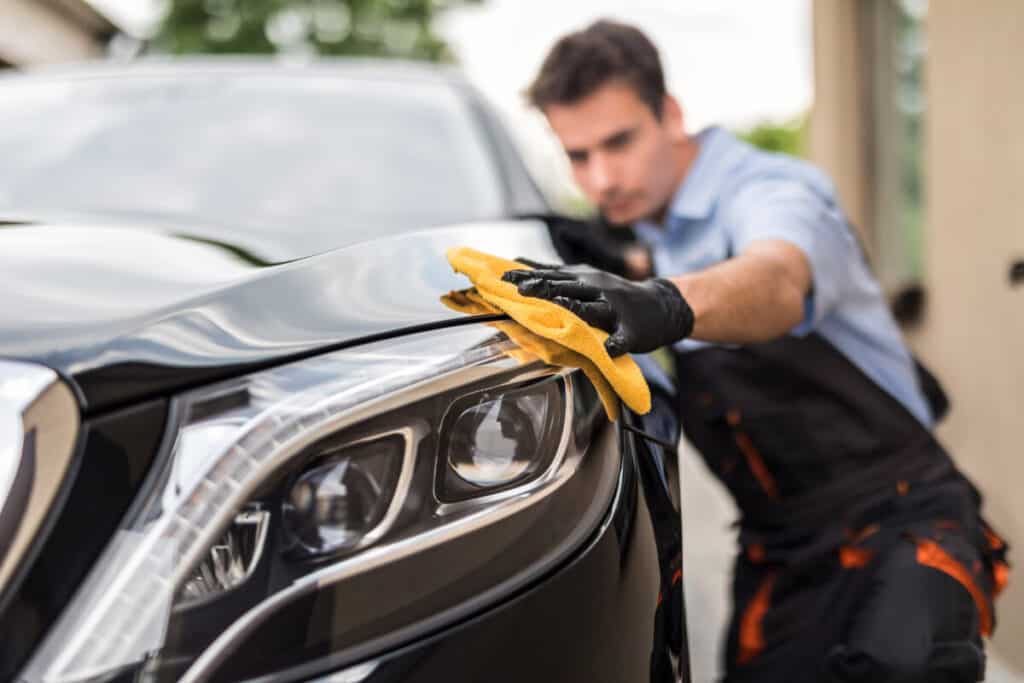Owning a car comes with a variety of experiences and responsibilities. Some of those experiences might be going on adventures and having food or drink in your car or having children in the backseat. Oftentimes and regardless of the care you put into your car, you will end up having something spill in your car.
Seat belts can be cleaned using hot water, cleaning products, scrubbing, soaking, and/or using a specialty cleaning tool like a hot water extractor. Popular cleansers include fabric cleaners, baby wash, and vinegar. Some detailing services use pressure washers for stubborn stains, although this may damage the fabric.
Now that we have a basic understanding of how to clean a seat belt, let’s look a little more into the specifics of why you should clean a seat belt, how to clean out certain stains, and what different tools you can use to clean a seat belt.

Tools for cleaning seat belts
There are many methods people recommend to use when you need to clean your car seat belts. There are people who recommend soaking it, some that will use a lot of scrubbing, and others that recommend using advanced tools to clean it.
People who soak their seat belts tend to use a mixture of water and additional cleaner. Some popular cleaners are detergent, baby wash, white vinegar, or de-greaser. Follow the instructions on the specific product you’ve picked to dilute the concentrated cleaner with water (if recommended on the product packaging).
Most methods of cleaning seat belts require scrubbing. For most stains, a soft-bristled brush (or even an old toothbrush) will do the job, but stubborn old stains may require a stiff bristle brush. One recommended using a magic eraser to scrub (Source).
Car detailing services tend to clean seat belts using a tool called a hot water extractor. A hot water extractor is like a vacuum that you fill with water. It takes water and cleaning solution, heats it up, injects it into the fabric, and then absorbs the dirty water afterward. Hot water extractors are often used for cleaning carpets and upholstery (Source).
Very tough stains are sometimes treated at detailing services with more powerful tools such as a steamer or a pressure washer. Both of these tools are incredibly effective at washing and removing stains from a seat belt. However, there is some argument that those tools are too powerful and can be detrimental to seat belts.

How to clean seat belts
Now that you have decided on a method and gathered the proper tools, now it is time to clean your seat belts! Regardless of the method you choose to clean your seat belt, you will need some form of cleaner, and a clip or some other tool you can use to keep your seat belt from winding back into the mechanism.
1. Hand scrubbing
If you’ve just got a few dirty spots on your seat belt, then you may be able to remove stains just by using baking soda or non-bleach dish soap and a little elbow grease. If you are using baking soda, you can make a little mix with some warm water. This is especially useful if there is a bit of a smell coming from the stain! Alternatively, you could mix some water, soap, and vinegar to get the stain and smell out. Use about one tablespoon of soap and two tablespoons of vinegar to every cup of water for best results. Vinegar-based cleaners also work well for this problem, of course!
Following instructions on the product, put the cleaner/degreaser on the seat belt. You might want to start on the really tough stains, just so you can give them extra attention. You want to make sure you don’t overdo the degreaser or any super strong cleaner as it can eat away at your seat belt. On that note, be sure to remove all of the product once you’re done!
You will then want to scrub it by hand, with a hard bristle brush or a magic eraser. Once you have scrubbed, it is now time to wipe off the seat belt with a clean towel and add a fabric protector. The fabric protector adds an additional preventative measure to keep them clean longer.
2. Soaking
If you decided to want to clean car seat belts by soaking, you will follow a similar process to hand cleaning. The main difference is that you will likely want to remove the seat belt from your car and let it sit in the hot, soapy solution for about half an hour. Something important to keep in mind is that you want to be confident you can reinstall your seat belts correctly.
The main idea behind this is to make sure that the seat belts are just as effective at keeping you and your passengers as safe as before you remove them. Once you soak and scrub, just like in the hand cleaning process, you will want to wait until the seat belt is completely dry before reinstalling/allowing it to rewind into the mechanism again. To do this, you can either let the belt air dry naturally or you can absorb the excess moisture with a dry microfiber towel.
If you forget to remove excess moisture and accidentally re-install a wet belt, you may end up dealing with mold. So, be sure to let the belt dry thoroughly!
3. Hot water extractor
Sometimes, spot cleaning or soaking isn’t enough for really dirty seat belts (especially for the driver’s seat belt, which gets used a ton)! If that’s true, you might want to use something a bit more heavy-duty like a hot water extractor.
If you are going to use a hot water extractor (or pressure washer), the process is streamlined. It is recommended you pull the seat belt completely out of the car and shut the door. This reduces the likelihood of your car getting water damage. Then you put on the cleaner of choice, scrub it, and hold it tightly for cleaning. Wash the belt one side at a time. Afterward, allow the belt to dry.
Why you should clean a seat belt
There are many reasons why you should take the time to clean a seat belt. Some of the important reasons you should clean a seat belt are cleanliness, making sure your seat belts work well, and odor.
Cleanliness is important, even in your car, because it helps promote healthy habits and seat belt usage. I have been in many cars with many seat belts and seen a variety of seat belt conditions. When you touch a seat belt and it is sticky or clunky due to previous spills, it makes it tempting not to buckle up. Cleaning helps promote buckling up and will also reduce germs and odors.
Clean seat belts also help keep seat belts working well. This is especially important because your seat belts offer protection to you and your loved ones. With poor maintenance, your seat belt could be sticky, grungy, and potentially ineffective at keeping you safe. You want to be sure that your seat belt is in top condition just in case you get in an accident.
Once you have decided that it is time to wash your seat belts, you need to gather the tools you need to be able to start the cleaning process.
Conclusion
We hope that you’ve found a way to clean your car seat belts, no matter how big or small the mess! For most problems, you can fix it with a simple fabric cleaner (or easy DIY mix). However you decide to clean, just make sure that you let everything dry completely before re-installing your seat belts.
Other cleaning articles
Some messes are easier to clean than others! Here are some other cleaning articles that may come in handy.
- How to clean a sheepskin rug
- How to clean the inside of a windshield
- How to get mascara out of clothes
- How to get detergent stains out of clothes
- How to clean seat belts
- How to get crayon stains out of clothes
Cleaning
You can also check out the cleaning category to see which other posts we have. Simply click the button below!

Leave a Reply